The phrygian scale is the third mode of the Major scale and is widely used in improvisational music such as jazz and flamenco. This scale is closely related to the minor scale but with a small twist by changing one of the notes which gives it its unique and mysterious sound.
In this lesson, we’ll cover the music theory for the phrygian scale, examples in different keys, learn the 5 phrygian scale guitar shapes, and application examples. Let’s get started!
Phrygian scale formula
If you start and end on the 3rd degree of the Major scale, you are playing a phrygian scale. For example, an E phrygian scale would have the notes E, F, G, A, B, C, and D. In terms of scale degrees, the notes are root, flat 2, flat 3, 4, 5, flat 6, and flat 7.
If you notice, there is only one note difference between the phrygian and natural minor scale. The phrygian scale has a flat 2nd scale degree, while the natural minor scale has a natural 2nd scale degree. For example:
- E phrygian scale: E, F, G, A, B, C, and D.
- E natural minor: E, F#, G, A, B, C, and D.
We can also look at the phrygian scale formula in terms of whole and half steps. The formula would be half, whole, whole, whole, half, whole, and whole step between the scale notes. See the image below.

You can also simply think of the parent scale that a phrygian scale comes from by counting 2 whole steps below or a minor 3rd interval below. For example, C phrygian would have the same notes as an Ab Major scale. Or D phrygian would have the same notes as a Bb Major scale.
Phrygian scale examples with tabs
Here are some different phrygian scales in music notation with guitar tabs below. The numbers above the notes on the top staff indicated which fingers to use on your fretting hand. If needed, check out how to read guitar notation symbols.
The following examples show you one way to play different scales in one octave but we’ll also cover how to play beyond one octave later in this lesson.
C phrygian scale example

D phrygian scale example

E phrygian scale example

F phrygian scale example

G phrygian scale example

A phrygian scale example

B phrygian scale example

Phrygian scales chart
The following chart shows you the notes for all phrygian scales.
| Phrygian scale | 1 | b2 | b3 | 4 | 5 | b6 | b7 |
|---|---|---|---|---|---|---|---|
| C phrygian scale | C | Db | Eb | F | G | Ab | Bb |
| D phrygian scale | D | Eb | F | G | A | Bb | C |
| E phrygian scale | E | F | G | A | B | C | D |
| F phrygian scale | F | Gb | Ab | Bb | C | Db | Eb |
| G phrygian scale | G | Ab | Bb | C | D | Eb | F |
| A phrygian scale | A | Bb | C | D | E | F | G |
| B phrygian scale | B | C | D | E | F# | G | A |
| Db phrygian scale | Db | D | E | Gb | Ab | A | B |
| Eb phrygian scale | Eb | E | Gb | Ab | Bb | B | Db |
| Gb phrygian scale | Gb | G | A | B | Db | D | E |
| Ab phrygian scale | Ab | A | B | Db | Eb | E | Gb |
| Bb phrygian scale | Bb | B | Db | Eb | F | Gb | Ab |
5 Phrygian scale guitar shapes
The following section shows you the 5 phrygian scale shapes throughout the guitar fretboard.
How to read the scale charts
For the charts below:
- The lowest horizontal line represents the thickest string (Low E). The top horizontal line represents the thinnest string (high E).
- The green circles represent the root note of the phrygian scale and the blue notes are every scale note in between.
- The numbers inside the circles represent the suggested fingering to use on your fretting hand.
If needed, check out how to read guitar notation symbols.
Phrygian scale shape 1
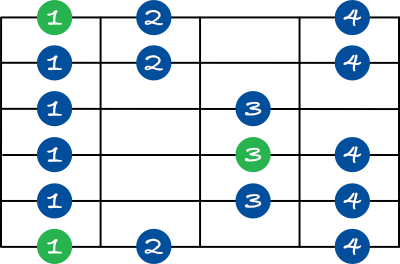
Phrygian scale shape 2
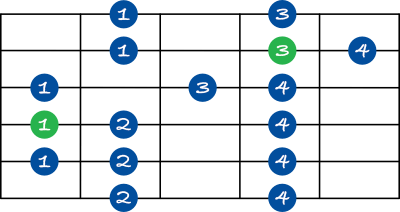
Phrygian scale shape 3
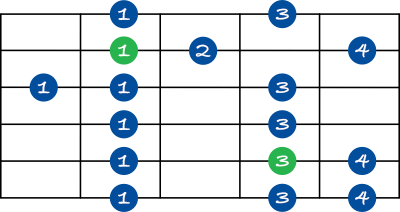
Phrygian scale shape 4
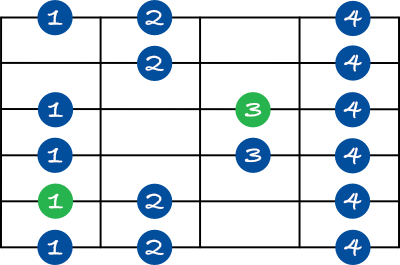
Phrygian scale shape 5
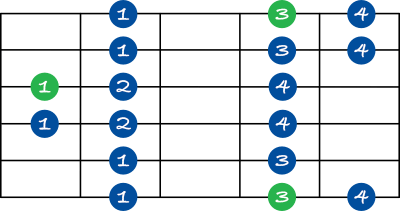
Phrygian scale guitar application examples
Generally, the phrygian scale works well on the 1 chord in a minor chord progression or over the 3 minor chord in a Major chord progression. Here are 5 application examples over different chords.
Application 1 – D phrygian scale

Application 2 – E phrygian scale

Application 3: B phrygian scale

Application 4: C phrygian scale

Application 5: A phrygian scale

Wrapping up
The phrygian scale has a dark but beautiful sound that will be worth adding to your toolbox for improvisation. The key is to know where to use it based on the chords of a progression. Instead of thinking of the natural minor scale, try using the phrygian scale to add a more dramatic sound to your playing.
You want to be able to memorize all the shapes well and then work on how to make the scale sound musical. For some ideas on how to do this, check out this lesson on how to practice scales on guitar. You may also want to learn how make your melody lines sound jazzy.
You can also see an overview of the Major scale modes and their related emotions here or learn the specific scales below:
- Ionian scale (Major scale)
- Dorian scale
- Lydian scale
- Mixolydian scale (minor scale)
- Aeolian scale
- Locrian scale
📘 Get the free guitar practice guide here!
All the best,
JG Music Lessons
📙 Kickstart your guitar playing with our step by step guide: Guitar Essentials.
🎸 Looking for a travel or half-sized guitar? See this one.
🛠 See our other music recommendations.
🤝 Support the site to help us to create better content for you!
Level up with the FREE guitar practice guide and effectively improve your playing! 🎸
Get it sent to your email!



